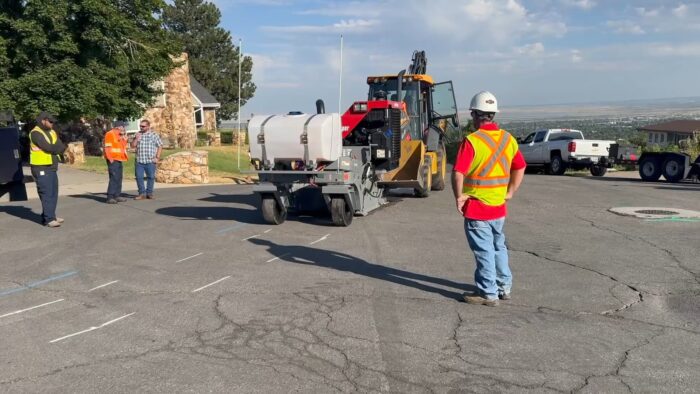Asphalt removal on underground utility projects costs a lot of money and takes a lot of time. You already know this, especially if you saw cut and chunk to open utility trench. Now utility contractors face a potentially bigger headache: asphalt disposal. What are you supposed to do with all of those awkward, heavy asphalt chunks?
(Spoiler alert: we have a solution to asphalt removal and asphalt disposal, a portable asphalt milling machine / asphalt grinder. With asphalt milling, you change your asphalt removal strategy, opening trenches much more quickly. Because the asphalt millings are spec-comparable material, they make great trench backfill. If you do need to dispose of them, asphalt millings are much more compact and easier to transport.)
Where Can I Dispose of Asphalt?

Back on topic, and as you are probably well aware, solid waste landfills don’t accept asphalt. Why? Because asphalt surfaces contain petroleum which can cause environmental and safety risks if not handled correctly. If your asphalt disposal process is to pile your asphalt chunks in a corner of one of your yards, you might want to reconsider.
Asphalt material contains hydrocarbons, which can leach into the soil and groundwater, creating potential contamination. Additionally, asphalt fumes are harmful to inhale, posing health risks to workers and the surrounding community. You might not be aware that asphalt is also flammable. Improperly managed asphalt chunks can ignite under certain conditions.
Because of these safety concerns, only construction and demolition (C&D) landfills accept asphalt chunks from utility trenching projects. As the population density increases in our communities, C&D landfills are filling up and becoming fewer and farther between. This leaves utility contractors with the headache and cost of asphalt disposal.
It also drives home the importance of finding alternative solutions like recycling asphalt. Portable asphalt milling machines or asphalt grinding machines are one such solution, using innovative technologies for asphalt removal.
If you are still doing things the old way, first, you need to find a C&D landfill that accepts asphalt chunks. Then, you need to determine how to transport the asphalt material to the disposal site.
Transportation increases fuel and labor expenses. It can also add significantly to the project timeline. Hauling asphalt over long distances can quickly send a project’s budget through the roof.
Coordinating asphalt transport with other aspects of an underground utility project can become a logistical nightmare. Most projects run on a tight schedule. Now, in addition to doing the utility project itself, you need to manage truck availability and landfill hours. These complications emphasize the need for more efficient and sustainable solutions to manage asphalt waste.
Space limitations have led some C&D landfills to stop receiving waste. The environmental protection agency (EPA) encourages recycling materials. “Reducing and recycling C&D materials conserves landfill space, reduces the environmental impact of producing new materials, creates jobs, and can reduce overall building project expenses through avoided purchase/disposal costs.”
How to Solve the Asphalt Disposal Problem
A portable asphalt miller, or asphalt grinding machine, “reduces and recycles” asphalt, creating recycled asphalt pavement. It grinds asphalt from utility trenches into reusable aggregate material. This recycling process creates material as fine as 1 1/2 inches in size.

If the project specs allow, you can use your portable “asphalt recycling machine” (asphalt grinder) to make recycled asphalt product (RAP) for trench backfill. By using your asphalt millings as trench backfill, you greatly reduce or even eliminate your asphalt disposal needs.
If you do need to dispose of asphalt grindings, they will be much more compact. This means it will cost less for transportation and dumping fees. The environmental and cost benefits of owning a portable asphalt milling machine or asphalt grinding machine are impressive.
Other Benefits of Owning an Asphalt Grinding Machine or Asphalt Miller
Sustainable solutions are important, but there are other reasons that an Asphalt Grinder is a good investment:
- A portable asphalt grinding machine can open 300’ – 500’ of utility trench every half hour.
- Vehicles can drive over the asphalt millings before you dig out the trench, minimizing traffic disruptions.
- You won’t need to spend time (and money) waiting for a subcontractor with an asphalt grinding machine to grind your utility trench for you.
- An asphalt milling machine efficiently and accurately mills asphalt for easy access to utilities without extensive surface disruption. This means faster access for pipe replacement projects and less downtime for you. In an urban area with high traffic volume, this is especially important.
- A portable asphalt milling machine’s compact size makes it ideal for tight spaces. This minimizes the need for additional heavy equipment.
Now is the time to change your asphalt removal process. Streamlining your asphalt grinding can save time and keep costs down on utility projects. If you own your own asphalt grinder or asphalt milling machine, you will score a significant advantage over competitors.
The problems of asphalt removal and disposal are here to stay. This highlights the need for a new way of doing things. Portable asphalt milling machines provide this environmentally friendly solution.
They allow contractors to grind paved areas of asphalt over utility lines into reclaimed asphalt pavement (rap). They also provide many other benefits. Pavement milling helps lower asphalt disposal costs and speeds up project timelines substantially.
By using an asphalt milling or asphalt grinding machine, utility contractors can tackle logistical and environmental challenges. They gain a competitive edge through cost savings, high quality operations, and a focus on sustainable practices. Investing in a portable asphalt grinder is a smart move that aligns with modern construction demands and environmental goals.